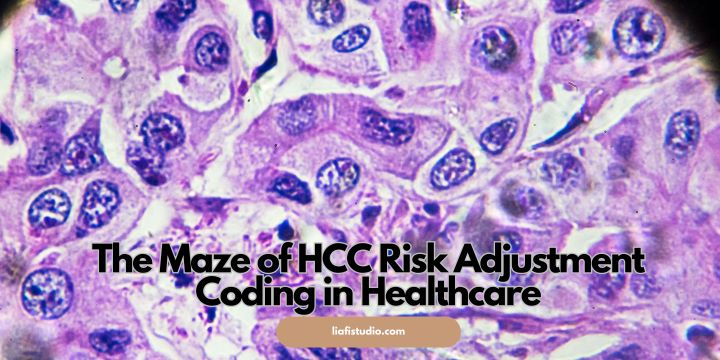Table of Contents:
- Understanding the Basics of HCC Risk Adjustment Coding
- The Importance of Accurate HCC Risk Adjustment Coding
- Technology’s Role in Enhancing HCC Coding Accuracy
- Training and Education for HCC Coding Excellence
- The Intersection of HCC Coding and Regulatory Compliance
- Analyzing the Financial Implications of HCC Risk Adjustment Coding
- Conclusion: The Pivotal Role of HCC Coding in Quality Healthcare
Key Takeaways:
- HCC risk adjustment coding plays a pivotal role in modern healthcare systems by matching financial reimbursement with patient care needs.
- With accurate coding, healthcare providers can ensure sustainable operations through fair compensation.
- Ongoing education and leveraging advanced technological tools like HCC coding software are crucial to achieving coding excellence.
- Comprehending the broad impact of HCC coding on patient outcomes and the healthcare economy is vital.
Understanding the Basics of HCC Risk Adjustment Coding
In contemporary healthcare, the financial remuneration for providers is intricately linked to the clinical complexity of the patients they serve. This system’s core lies in Hierarchical Condition Category (HCC) risk adjustment coding. Intended to ensure that health plans accurately estimate future healthcare costs, these strategic codes are used to adjust capitated payments to healthcare providers for the specific health expenditures of their enrolled members. As we move into an era of healthcare where precision is paramount, HCC codes become not just about accuracy but also a means to facilitate preventive care by earmarking resources where they are most needed.
The Importance of Accurate HCC Risk Adjustment Coding
Gone are the days when medical coding was just about record-keeping. In the present landscape, HCC risk adjustment coding is fundamental to healthcare organizations’ operational and financial health. Precise coding translates into the healthcare provider adequately compensating for the complexity of care provided to patients, particularly in managed care environments. This, in turn, is directly tied to patients’ quality of care, as resources can be better allocated and managed to address individual health needs. The weight of accurate coding is thus two-fold, impacting both the sustainability of healthcare provision and the well-being of patients.
The importance of accurate coding is underlined by the fact that Medicare and other insurers base their payments more on the health status of the patients rather than service quantity. A healthcare provider’s financial viability thus hinges on capturing a complete and accurate picture of a patient’s health through HCC codes. This is where tools like HCC coding software come into play—streamlining the coding process and ensuring that all relevant codes are captured for each patient encounter.
Technology’s Role in Enhancing HCC Coding Accuracy
As healthcare progresses, technology becomes an increasingly influential player. Advanced HCC coding software development has provided a significant leg up in tackling the challenges of risk adjustment coding. Such platforms can sift through vast amounts of data, flag discrepancies, suggest accurate codes based on clinical data, and even monitor coding performance over time. These technological solutions offer considerable benefits, including streamlined data handling, increased coding speed, and improved accuracy.
The potency of such software is only magnified when combined with the expertise of skilled coders. It’s akin to providing a seasoned navigator with a state-of-the-art compass; the result is a more precise and efficient journey through the coding process. Healthcare organizations can achieve a level of accuracy that not only complies with regulatory demands but optimizes revenue cycles, thus further enabling the delivery of high-quality care.
Training and Education for HCC Coding Excellence
Education is the cornerstone of excellence in HCC coding in a field that continually adapts to new medical practices and guidelines. Regular training programs and certifications ensure HCC coders are current with the latest coding practices and standards. This educational focus maintains a coder’s ability to navigate the intricate coding environment with finesse. Furthermore, investing in coder education acts as a quality assurance measure, ensuring that the coding that forms the basis for risk adjustment is carried out with precision and accuracy.
Education extends beyond formal training; it includes staying informed about the latest industry news and insights. Continuously updating one’s knowledge base with resources and guidelines empowers coders to remain agile and competent in healthcare’s dynamic nature. Moreover, this ongoing learning process can reveal strategies for optimization and innovation within the HCC coding sphere.
The Intersection of HCC Coding and Regulatory Compliance
One must discuss HCC coding by addressing the considerable regulations that govern it. Ensuring compliance with these regulations is paramount; non-compliance can result in financial penalties or legal repercussions. Thus, HCC coding is not just a revenue-centric activity—it is steeped in the legal framework of healthcare reimbursement.
Maintaining compliance isn’t just about avoiding negative consequences; it’s about fostering a culture of ethics that underpins the entire healthcare industry. Coders must be proficient in the technical aspects of HCC coding and understand and execute the coding within regulatory standards. This intersection of coding acumen and regulatory adherence is crucial for the overall balance and equitability of healthcare delivery and funding.
Analyzing the Financial Implications of HCC Risk Adjustment Coding
The interplay between accurate HCC coding and the financial health of healthcare institutions is complex and significant. Appropriately captured HCC codes enable providers to receive the rightful reimbursement for the complexity of care administered to their patient populations. This directly influences resource allocation—ensuring that medical facilities stay solvent and competitive in an industry where care needs and financial capabilities must be constantly balanced. Moreover, the financial predictability provided by accurate risk adjustment allows healthcare providers to plan and budget for patient care more confidently, stabilizing the healthcare market and allowing for strategic investment in patient services.
Conclusion: The Pivotal Role of HCC Coding in Quality Healthcare
In closing, healthcare professionals must navigate the HCC risk adjustment coding labyrinth with care and precision. It goes beyond the mechanics of coding to touch the essence of healthcare—ensuring patients receive high-quality care commensurate with their clinical needs. As healthcare moves forward, the role of HCC coding in supporting sustainable healthcare models is only set to increase. It anchors the healthcare ecosystem, bridging clinical care and financial reimbursement, guiding the allocation of resources, and safeguarding the balance between quality care and economic viability.
For those in the healthcare industry, continuing to illuminate the importance of HCC coding and embracing tools and education to enhance its accuracy is not just a financial imperative—it’s a commitment to the health and well-being of every patient they serve.







